Chapter 1: Wherein the FrankenStitch is Revealed

A single Stella lamp casts a bright light on a pair of unmanicured hands in a shadowy room. As the embroiderer hunches over her bizarre creation, she hums a tune only she can hear.
Removing her earbuds, she grins and pops another cookie in her mouth. Like an alchemist, the stitcher gathers her discarded textiles to admire the glow of fabric and thread. It is taking shape this peculiar stitchery made from disparate parts.
Another Frankenstein embroidery is born!
Bwahahaha!
What drives our embroiderer to create such an unnatural embroidery? This FrankenStitch? What exactly is a FrankenStitch embroidery anyway?

Like The Frankenstein, FrankenStitch embroidery is created by combining partially finished embroidery parts like these and stitching them together.
As a result, you make artwork with a pleasant personality rather than an unruly neighbor with big boots.

So gather, if you will, to read the tale of this FrankenStitch.
For the next few days, I’ll tell you the story of this strange embroidery and how the embroiderer with the ragged cuticles laboriously wends the needle in and out and in and out cookie after cookie.
You’ll learn how a few innocent parts stitched together create this new embroidery design.
Bwahahaha!
Chapter 2: Wherein We Learn the Origins of FrankenStitch
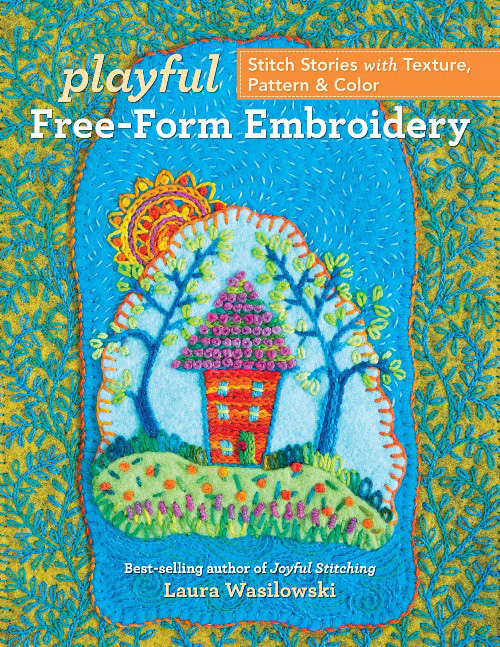
Once upon a time, there was a book called Playful Free-Form Embroidery.
Six cheerful hand embroidery projects featured in the book; designs made with colorful felt and wool. The intrepid author labored over the embroidery to create the projects for over a year.
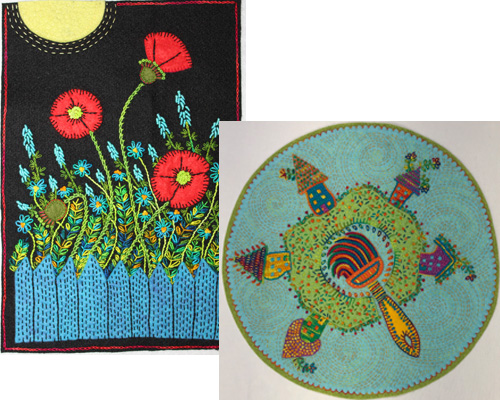
Two projects, Natural Gardening and Painting the Town, required hours of stitching to show the stages or step-outs to make the artwork. And so the author of the book made step-out after step-out to illustrate the book and please her editor.

After months of work, the editor accepted the multitude of embroidery step-outs and requested they be photographed in the distant state of California. The exhausted author shipped the step-outs via FedEx with the editor’s promise to publish the book the following spring.
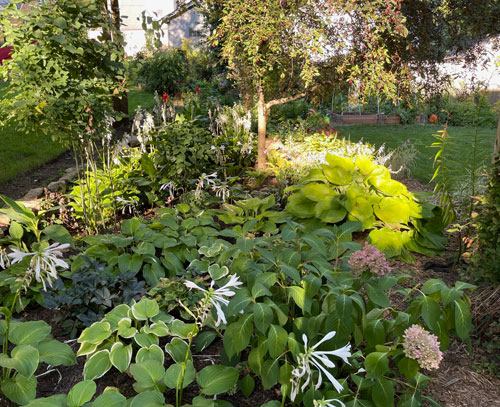
After returning from Fedex, the embroiderer felt the kink in her neck ease. Her work was done. It was up to the slew of editors at the C&T publishing house to complete the book and bring it to the public. She returned to her hobbies of gardening and cursing mosquitoes. Her cuticles grew even more ragged and neglected.
Months later, a box arrived on her doorstep. The embroiderer swatted at the mosquitoes surrounding the box and squinted at the return address label. The editor had returned the forgotten step-outs. With a familiar kink returning to her neck, the author dragged the box to her studio and dropped it on the floor.
Chapter 3: Wherein the Embroiderer is Haunted

Upon opening the box from her editor, the embroiderer glowered at the step-outs from her book, Playful Free-Form Embroidery. Eager to return to her garden, she tossed the step-outs in the Elfa baskets carefully purchased for her new studio. The Elfa shelving system groaned under the weight of the step-outs. She slammed the cupboard door shut and switched off the studio light.

But the step-outs called to her. They haunted her waking moments as she weeded her garden and killed mosquitoes. It was as if the heartless Elfa baskets begged her to return to the studio.

One day the embroiderer cleaned the damp soil from her Sloggers chicken gardening shoes and paused at her studio door. Perhaps one peek a the step-outs would end the haunting. Maybe one glance at the step-outs would reaffirm her wish to put the book’s stitching behind her.
Or would it?
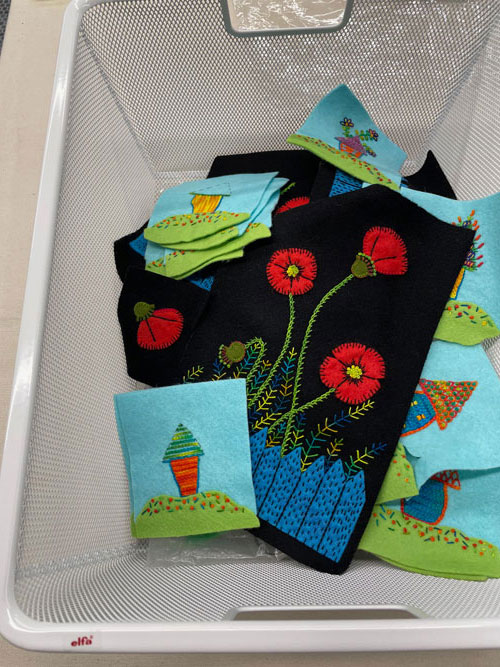
The embroiderer slowly drew an Elfa basket from the cabinet. What was it that compelled her to sort through the step-outs? Her fingers itched to touch the texture of each one, to caress the threads she had stitched so long ago.
As she forced herself to return the step-outs to their Elfa basket her eyes fell on swatch of black wool with bright red flowers and the small house that lay like a companion next to it. It was as if the moonlit garden longed for the promise of daylight as if the tiny house wished for a home.
Chapter 4: Wherein the Embroiderer is Seduced
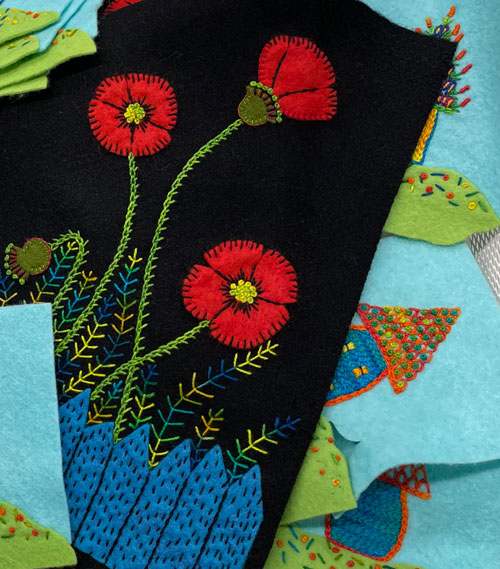
The embroiderer slowly drew the black wool with bright red flowers and the tiny house from the storage basket. She recalled her reluctance to view the step-outs after a year of laboring over her Playful Free-Form Embroidery book. She also recalled that her back was killing her from weeding the garden.
Maybe it was time to sit for a bit and stitch indoors without a swarm of mosquitoes eating her alive. Besides, the step-outs looked so innocent, so friendly.
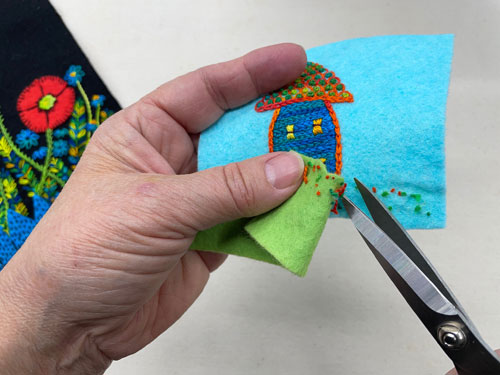
So in a flurry of activity (and with a mild twinge in her back), she grabbed her scissors, rushing to snip the threads holding the grass shape below the house step-out.

Her hands twisted the house shape and sought the scissors again, only to trim the light blue felt fabric into a cloud shape encircling the house.

Then she hurriedly removed the bright red flower on the right of the black fabric and tossed it into the trash along with her cookie wrappers.
Sure she ate a lot of cookies, so what? It was the flower she had to give up, not the cookies.
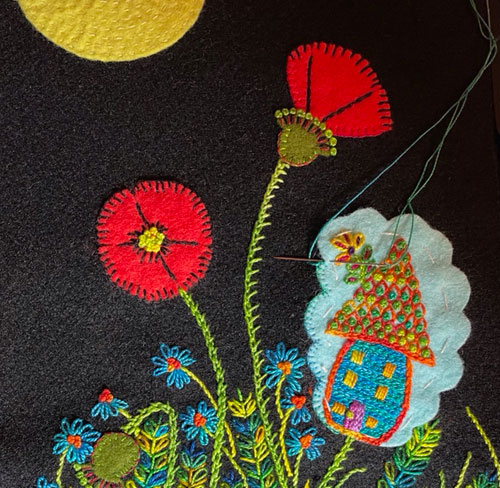
As she stitched the house where the red flower had been, she thought, “What madness was this? Tomorrow I must return to my garden. That bindweed is choking out the beans and the tomatoes are looking a little verklempt”. But then she laughed and bent over the embroidery again and popped another cookie into her grinning mouth.
Chapter 5: Wherein the Embroiderer Has Regrets
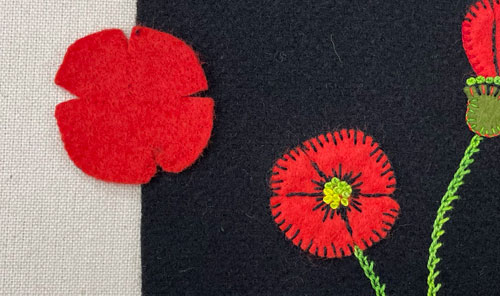
The next day, the embroiderer returned to the studio and took up the step-outs from her Playful Free-Form Embroidery book. Then, feeling regret for having tossed the red flower in the trash bin with her cookie wrappers, she rescued the flower and placed it on the edge of the design. Surely the flower would hold no grudge.

Then in a show of bravado, she cut the flower in half and stitched it to the edge of the design. It is now a sad half-flower. A tragic reminder that her rash use of the scissors has caused more than one regret in her life. But she can’t think about that now. There is more stitching to do.
Her attention rested on the yellow orb in the sky. Was it, in fact, the moon as suggested in her original Natural Gardening design? With the addition of the house, didn’t it more sensibly represent the sun rather than a moonlit garden?

And so she embellished the yellow orb, adding a jolly blanket stitch to trim the edge and fly stitches to create rays. She chose a size 8 pearl cotton thread called Butter from the quaint Artfabrik dye shop located in the state of Illinois. The Artfabrik dyer was known to favor cookies much as the embroiderer did. And so she trusted the dyer and thus the quality of her threads.
Chapter 6: Wherein the Embroiderer is Contrite
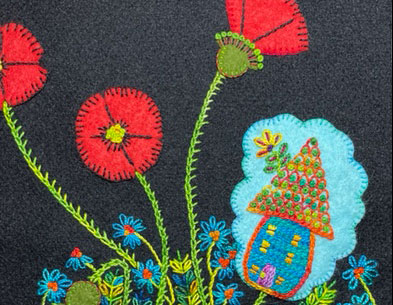
The embroiderer gazed with dismay at the FrankStitch design, a combination of step-outs from her book Playful Free-Form Embroidery. The half-flower looks so sad. Why had she cut it down the center following the straight edge of the black fabric?

Then, in a show of solidarity with the tragic half-flower, the embroiderer trims the remaining edges of the design in organic curves. But it is not enough.
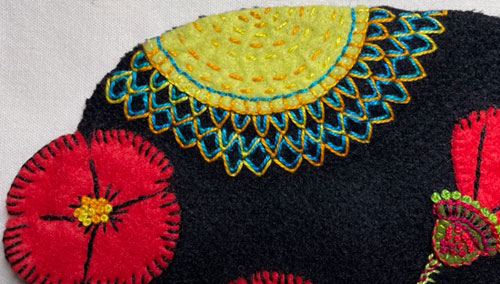
So the embroiderer snips off the sad half-flower and replaces it with a full flower that extends over the edge of the design. Yes, she regrets her rash use of the scissors in the past. But this time, she tries to make up for it.
Returning to the design, the embroiderer again selects a hand-dyed thread from the enigmatic Artfabrik dyer. It is a size 8 Aquamarine thread that repeats the rich hues of the stitched garden. She applies a backstitch around the sun’s edge using the blue thread, then echoes the yellow fly stitches that form the sun’s rays. The reward of another cookie lures her ever onward.
Chapter 7: Wherein the Embroiderer Is Led Down the Garden Path
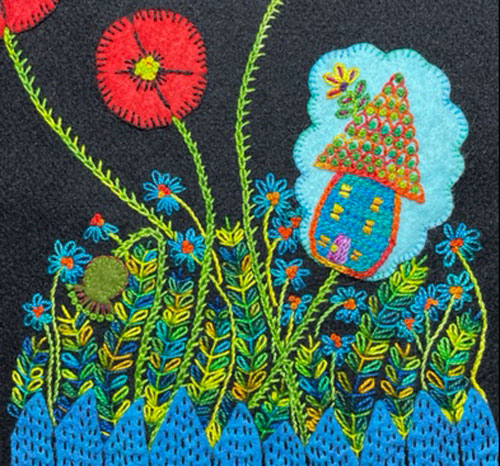
The embroiderer shuffles back into the studio with a hot cup of tea and several cookies. What more can she do to bring the FrankenStitch to life? Her memory of the dread when her editor returned the step-outs for Playful Free-Form Embroidery has disappeared like a packet of cookies. Instead, she now sees the odd parts as a familiar whole. They are becoming a new design, a unified embroidery with personality, quirks, and a sprinkling of cookie crumbs.

And so, she concentrates on the garden areas of the design, filling in the black background fabric with seed stitches here and adding straight stitches inside a lazy daisy stitch there. The fine size 12 Pickle Juice and heavier size 8 Ocean from the elusive Artfabrik dyer fit the color scheme and sew like butter.
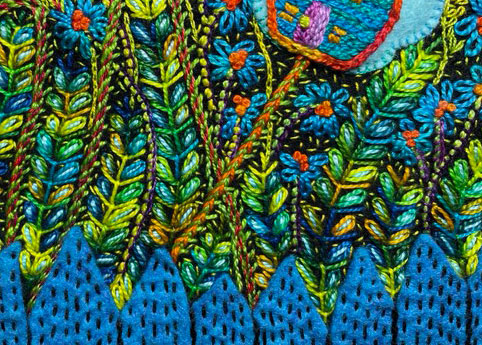
Whip stitches in bright Oranges thread lace through the birdhouse stick and the stems of the red flowers. The blue daisy stems are crisscrossed with blanket stitches using Bordeaux (the thread, not the wine).
It is not lost on her that her indoor hand embroidery “garden” replaced her outdoor gardening. Both indoor and outdoor activities soothe the soul. Although with indoor gardening, you can munch cookies while stitching. And there are no mosquitoes.
Chapter 8: Wherein the Embroiderer Squints Her Eyes
The embroiderer draws a deep breath cursing the needle jabbing into her thumb. Will this FrankenStitch creature never be done! Evolving from the Playful Free-Form Embroidery step-outs, it is slowly gaining a life of its own. Only a few more details to add, and maybe she can rest her weary fingers and finish the bag of cookies.

She casts a critical look over the design. What does it lack? What will breathe even more life into it? Snatching up a narrow length of green felt, she snips it into shape and places it on the lower edge of the blue fence. A fern stitch made with a size 8 Lime Frappe thread from the mysterious Artfabrik dyers cascades down each spike of fabric. This green fabric repeats the garden colors and theme and finishes the lower edge neatly.

Then she squints her eyes and gasps in disbelief. She has forgotten to repeat the red hue found in the large flowers! How could such an error escape her notice? It must be from lack of sustenance. And so she stacks fly stitches atop each other to make jaunty flowers above the pointy fabric using a size 12 red hots thread.

Shuddering with relief, the embroiderer adds a sweet little French knot to each bloom and rewards herself with yet another cookie. Yes, repetition is a good element of design to remember when creating artwork. And the repetition of color is among the best.
Chapter 9: Wherein the Embroiderer Completes the Creation
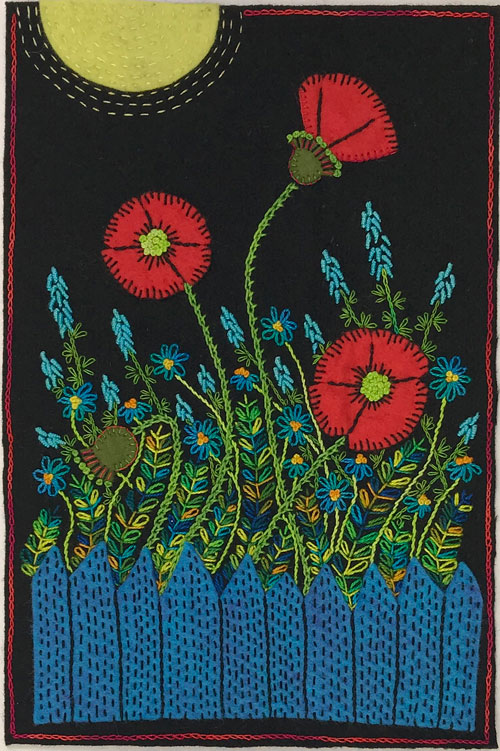
The embroiderer nestles into her comfy chair and takes up her FrankenStitch design. The artwork resembles its sibling called Natural Gardening (left) from Playful Free-Form Embroidery but with a flair for the dramatic. Just a few more stitches and it too will be complete.
And none too soon, for she is almost out of cookies

She adds blooms made with French knots to soften the horizon line. A size 12 Prinky Phlox from the now infamous Artfabrik dyers does the job.
Then she contemplates the sky. Can she transform the formidable black fabric with curved lines of stem stitches? Having no better ideas, she renders the lines on the sky with a size 12 Ocean thread. She likens the undulating lines to a crisp spring breeze or perhaps a bizarre cloud formation. Cumulus FrankenStitchius?

All that is left are a few stitches on the sun to perk it up. The embroiderer contemplates her handiwork. The FrankenStitch, a design born from unwanted step-outs, is finished. She sets it aside and grabs one last cookie. It is time to return to her real garden and the weeds that await.
Epilogue: Wherein the Embroiderer’s Lightbulb Goes On
It was a dark and stormy night when the embroiderer walked into her basement studio and the lightbulb in her brain finally lit up. At last! A way to finish her FrankenStitch design!

She centered the embroidery onto a piece of her hand-dyed fabric that was fused to a rectangle of wool batting. As she admired the pickle color of the cloth, she decided that her choice of color was a really big dill.
After attaching the embroidery to the cotton border fabric with hand stitching, she rushed to her sewing machine. (Ok, maybe she didn’t rush.) The embroiderer casually sauntered to her sewing machine.

Dropping the feed dogs on the machine, she casually added free-motion stitching to the green fabric. She chose the famous curlicues and bananas pattern of stitching to surround the embroidery thinking it added a bit of festivity.
As she completed the project, the embroiderer sighed and glanced around the studio. Suddenly she felt at loose ends.
But wait! Was that a small unfinished embroidery peeking out from under a stack of fabric. Was another FrankenStitch project lurking in the wings? Perhaps a Daughter of FrankenStitch? Stay tuned!
